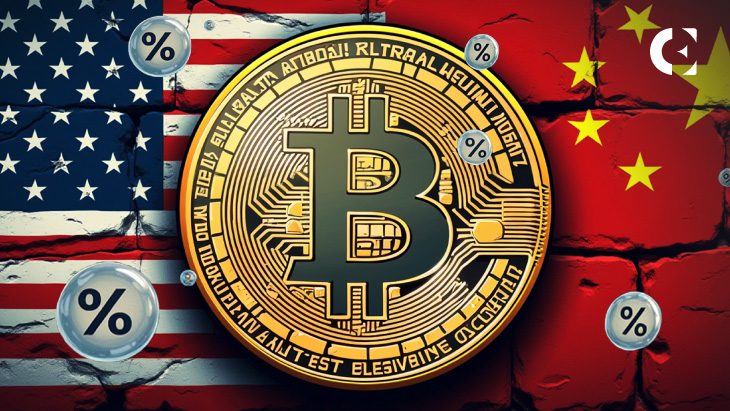Bitcoin: Navigating 125% US-China Tariffs

- China has escalated trade tensions by increasing tariffs on U.S. imports from 84% to a substantial 125%.
- This action comes as a direct response to the United States’ own recent tariff hike on goods from China.
- Beijing has stated firmly that it will not react to any further tariff increases from the U.S. beyond this point.
Starting April 12, 2025, China will raise tariffs on imports from the U.S. to 125%. This move is in direct retaliation to the U.S.’s prior decision to increase tariffs on Chinese goods to the same level. The Chinese government has labeled the U.S.’s initial action as a breach of established trade rules and standard economic practices.
China Responds to U.S. Tariff Increase
The State Council Tariff Commission made the official announcement of this tariff increase today, April 11th. The new 125% rate will replace the previous tariff of 84%, which was set in March. This decision is a direct consequence of the U.S. government’s announcement on April 10th that they would be raising tariffs on Chinese exports to 125% under what they termed a “reciprocal tariff” plan.
These newly imposed tariffs by China will affect a wide range of goods imported from the United States. According to the commission, U.S. products are already struggling to compete in the Chinese market even at the previous tariff levels.
Related: Billionaire Investor Ray Dalio Warns that Tariffs are Only the Beginning
“Considering the lack of market viability for U.S. goods even at current tariff levels, China has indicated it will disregard any further actions from the United States,” the official statement declared. These new measures are grounded in China’s Tariff Law, Customs Law, and Foreign Trade Law, and are also in line with the accepted principles of international law.
Beyond just this tariff increase, the commission also clarified that all stipulations and details from their previously issued announcements will remain in full effect. These earlier announcements contained lists of specific products affected and their corresponding tariff schedules.
Finance Ministry: U.S. Tariff Strategy “A Joke”
Meanwhile, China’s Finance Ministry has issued a strong condemnation of the latest tariff actions by the United States. The ministry stated, “Even if the U.S. were to continue escalating tariffs further, it would no longer be economically sensible, and would frankly become laughable in the context of global economic history.”
The statement continued with a warning, “However, should the U.S. persist in substantially infringing upon China’s interests, China will respond with unwavering resolve, fighting to the very end.”
U.S. Tariff Policy and Global Response
Earlier in April, the U.S. government implemented a broad set of “reciprocal” tariffs. While many nations were granted a 90-day grace period from these tariffs, China was notably excluded from this suspension.
In a post on social media, President Trump accused China of demonstrating “a lack of respect” for global markets and promptly announced an immediate tariff increase to 125%.
Across the Atlantic, German Finance Minister Joerg Kukies commented that the EU might need to consider its own response if discussions with the U.S. prove unsuccessful. He advised the EU to adopt a carefully considered approach, highlighting Europe’s trade surplus in goods alongside a deficit in services. He also advocated for strengthening Europe’s digital services sector to lessen reliance on U.S. providers.
Crypto Market Trades Sideways
This sudden intensification of trade tensions between the US and China immediately sent ripples through cryptocurrency markets, causing considerable volatility. For example, Bitcoin’s price dipped below $74,000 before partially recovering to around $81,500. Simultaneously, Ethereum’s price also saw a downward trend, decreasing by over 2% in 24 hours to approximately $1,548.
Related: Tariff Shock Reveals a Two-Tier Crypto Market: BTC vs Everyone Else?
Market analysts suggest this downturn is driven by investor worries regarding a potential slowdown in the global economy and increasing inflation, both fueled by the escalating tariff war. Although the immediate impact has been negative (“bearish”), some market observers believe that cryptocurrencies, particularly Bitcoin, could become more attractive in the long run.
Their reasoning is that Bitcoin could act as a safe haven or “hedge” against economic instability, especially if the current geopolitical tensions persist or worsen.
Disclaimer: The information presented in this article is for informational and educational purposes only. The article does not constitute financial advice or advice of any kind. Coin Edition is not responsible for any losses incurred as a result of the utilization of content, products, or services mentioned. Readers are advised to exercise caution before taking any action related to the company.











